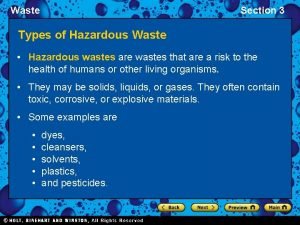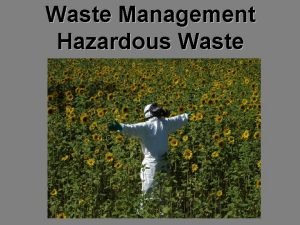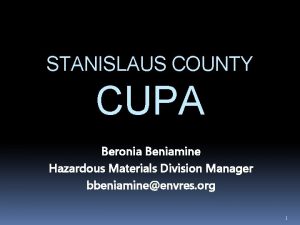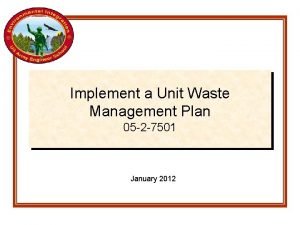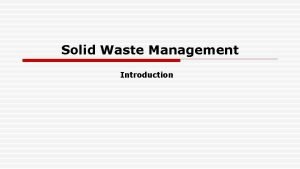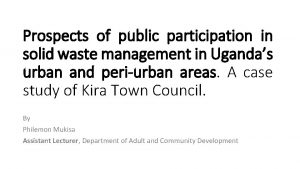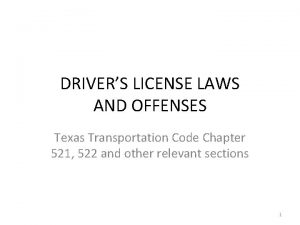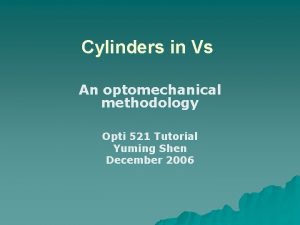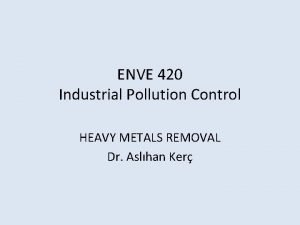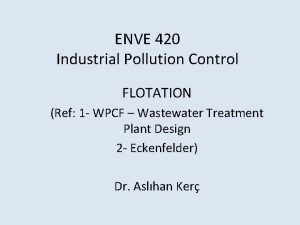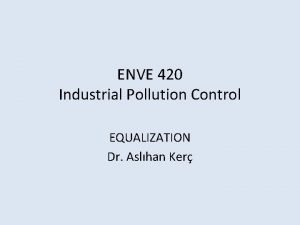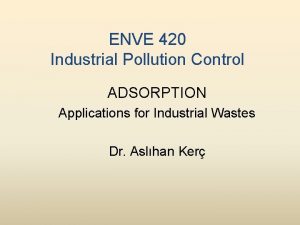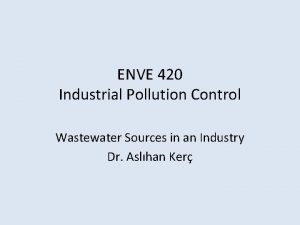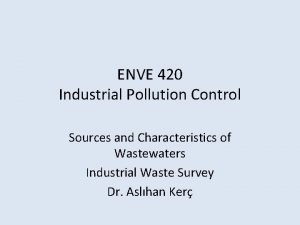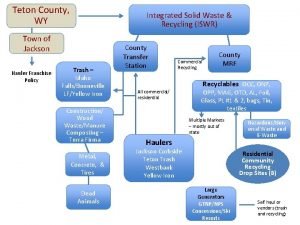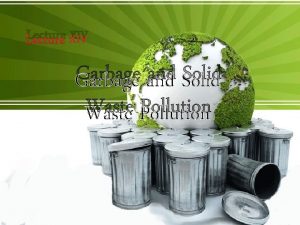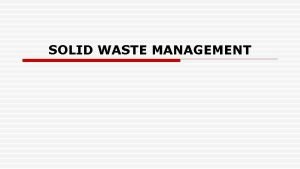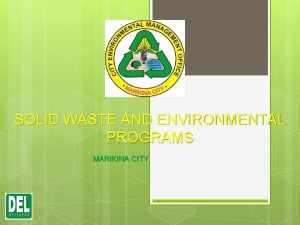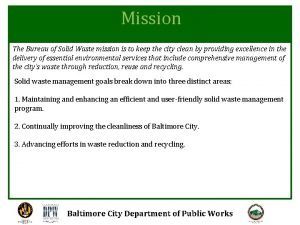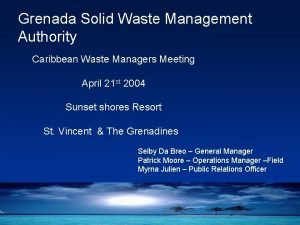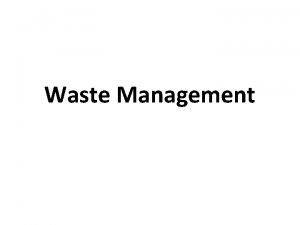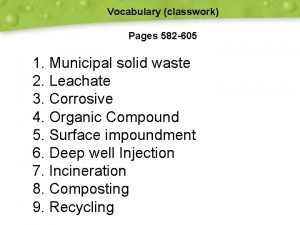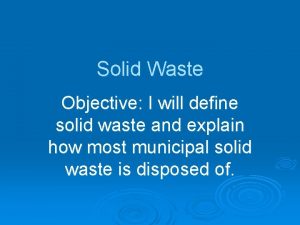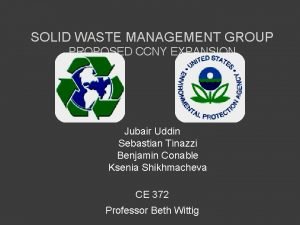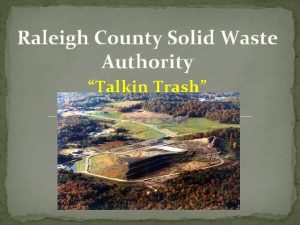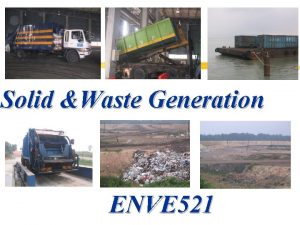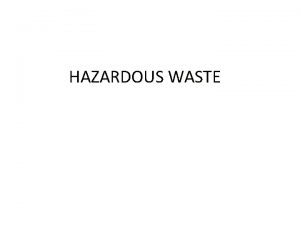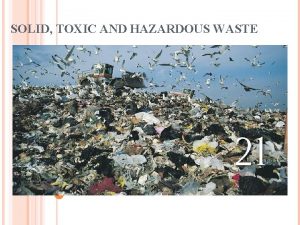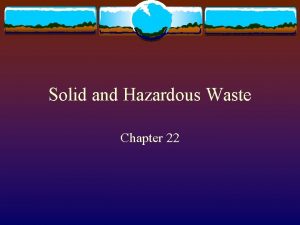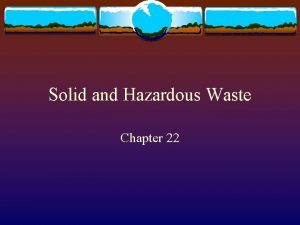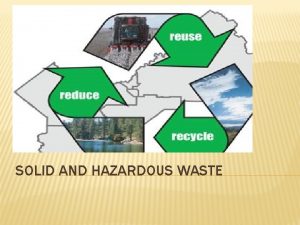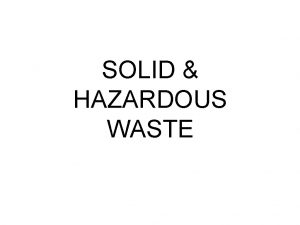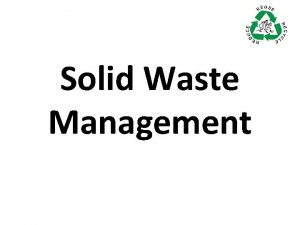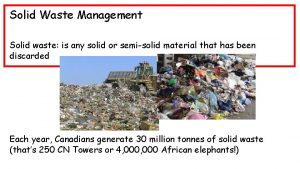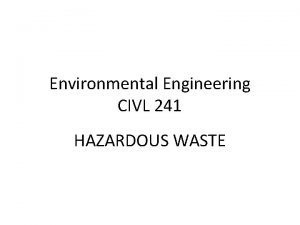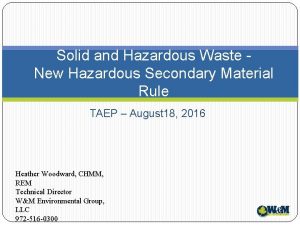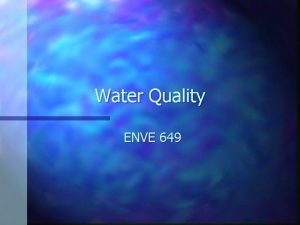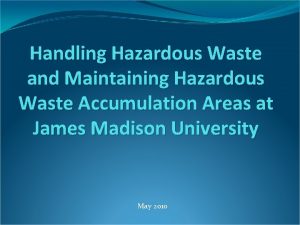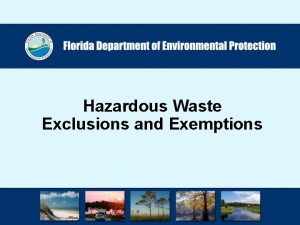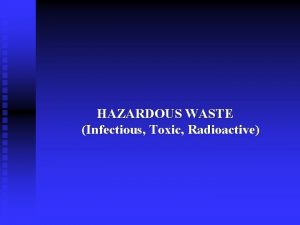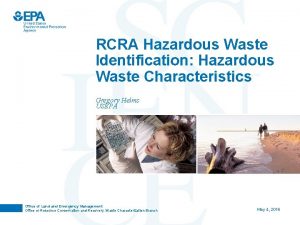Solid and Hazardous waste Engineering ENVE 521 INTRODUCTION


















































- Slides: 50

Solid and Hazardous waste Engineering ENVE 521

INTRODUCTION 1. Definition i) Solid wastes Solid waste are any solid object, (not liquid) that has no value to its processor and wants to dispose of them. ii) Solid waste management system A Management system to utilize solid waste in the most -effective combination of management options to handle waste or wastestreams within the confines of 2 applicable regulations.

GENERATION OF SOLID WASTES Source - fixed, permanent -Residential, commercial, industrial, open area, treatment plant, agricultural, demolition Source - non-specific, diffuse -This is in contrast to residential, industrial and commercial sources which are also diffuse but specific in that the generation of the wastes is a recurring event. -Wastes from hospital, veterinary, condemned goods, unfit food, abattoir. 3

GENERATION OF SOLID WASTES 2. Sources of Solid Wastes (7 Major Sources) Typical solid waste generating facilities, activities and locations associated with various source classification 4

GENERATION OF SOLID WASTES 5

GENERATION OF SOLID WASTES 6

GENERATION OF SOLID WASTES Residential Solid matter originated from household units such as, food waste, paper item, plastic container, glass, bottle, dust, ceramic product, yard waste (grass, branches, wood) and unwanted household items such as chairs, bed, electric goods and etc. 7

GENERATION OF SOLID WASTES Commercial Solid waste originated from office, bank, retail shop, eating house, school, hospital. Most waste originated from packaging works. 8

GENERATION OF SOLID WASTES Industrial Waste originated from product processing activities or wasted end product. Example: sludge from WWTP, chemical waste and packaging boxes. 9

GENERATION OF SOLID WASTES Special Wastes (Open area) a. Special wastes include street sweepings, roadside litter, litter from municipal litter containers, catch-basin debris, dead animals, an abandoned vehicles, waste oil etc. 10

GENERATION OF SOLID WASTES Treatment Plant Wastes The solid and semisolid wastes from water, wastewater, and industrial waste treatment facilities. The specific characteristics of these materials vary, depending on the nature of the treatment process. The trend is that disposal from treatment plant will become a major factor in any solid waste management plan. 11

GENERATION OF SOLID WASTES Agricultural Wastes and residues from diverse agricultural activities, such as the planting and harvesting of row, field, and tree and vine crops, the production of milk, the production of animals for slaughter, and preparation of feedlots. Characteristics - mainly organic and easily degradable. The disposal of these waste is not the responsibility of most municipal and country solid waste management agencies. 12

GENERATION OF SOLID WASTES Demolition and construction wastes ' Demolition wastes from razed buildings and other structures. ' Construction wastes from construction, remodeling and repairing of individual residences, commercial buildings and other structures. Including stones, concrete, bricks, plaster, lumber, shingles and plumbing heating and electrical parts. Difficult to estimate and variable in composition. 13

GENERATION OF SOLID WASTES Characteristics - mainly non-combustible such as stones, loose concrete, bricks, plaster, plumbing, heating and electrical parts. Combustible such as wood. 14

GENERATION OF SOLID WASTES 3. Types of Solid Wastes (Waste Characteristic) i) Food wastes (Garbage) Material such as meat, fats, fruit, or vegetable residue from handling, preparation, cooking and eating of foods. Characteristic - can be easily rotten (putrescible) and will decompose rapidly which will lead to the development of offensive odours. [Apart from those generated at residences, considerable amounts are generated at fast-food shop, cafeterias, restaurant, large institution, markets (wholesale & retail)] 15

GENERATION OF SOLID WASTES ii. Rubbish Wastes other than food from house holds, institutions, commercial activities, etc. , which consists of combustible and noncombustible solid wastes. Combustible rubbish includes (mainly organic) * paper *cardboard *plastics *textiles *rubber * Leather *wood *furniture * garden trimmings 16

GENERATION OF SOLID WASTES Noncombustible rubbish includes (mainly inorganic) *Glass * tin cans *aluminum *ferrous and other nonferrous metals * dirt 17

GENERATION OF SOLID WASTES iii) Ashes and residues Materials remaining from the burning wood, coat, and other combustible wastes. From homes, stores, institutions, industrial and municipal facilities for purposes of heating, cooking, power generation and disposing of combustible wastes. Characteristics - Ashes and residues are normally composed of fine, powdery material cinders, clinkers, and small amounts of burned and partially burn materials. 18

GENERATION OF SOLID WASTES 4. Physical Composition of Solid Wastes i) Individual component 19

GENERATION OF SOLID WASTES ii) Particle size Screens - 160 mm - 80 mm - 40 mm - 20 mm below is “fines” - 10 mm - 5 mm 20

GENERATION OF SOLID WASTES iii) Moisture content The moisture content of solid wastes usually is expressed as the mass of moisture per unit mass of wet or dry material. Wet Weight Moisture Content (%) = [ (a-b) / a ] x 100 where a = initial mass of sample as delivered b = mass of sample after drying 21

GENERATION OF SOLID WASTES *Drying condition is in a over at 77 o. C(170 o. F) for 24 hours. This temperature is used to dehydrate the material completely and to limit to vaporization of volatile materials. Dry Weight Moisture Content (%) = [(a-b) / a ] x 100 where a = initial mass of sample as delivered b = mass of sample after drying 22

GENERATION OF SOLID WASTES For most industrial waste, the moisture content will be in the range of 10% to 35% 23

GENERATION OF SOLID WASTES Question 1: Estimate the moisture content of a solid waste sample with the following composition: 24

GENERATION OF SOLID WASTES Solution Steps (1) Set up a computation table (2) Determine the dry mass of the solid wastes sampling using the data given in the Table. (3) Determine the moisture content using Equation and the data from above table 25

GENERATION OF SOLID WASTES iv) Density The density of solid wastes usually is expressed as the mass of material per unit volume of waste Density = mass / volume (kg/m 3) 26

GENERATION OF SOLID WASTES Because the densities of solid wastes vary markedly with geographical location, season of the year, and length of time in storage, great care should be used in selecting typical values. 27

GENERATION OF SOLID WASTES Question 2: Estimate the “as-discarded: density of a solid waste sample with the composition given in the example. 28

GENERATION OF SOLID WASTES Solution Steps (1) Set up a computation table (2) Determine the as-discarded volume of the solid waste sample using the data reported in Table (3) Compute the density of a waste sample using the data from above table 29

GENERATION OF SOLID WASTES Solutions 1 & 2: Estimating the moisture content and density of a solid-waste sample Composition of Mass for a solid-waste sample 30

GENERATION OF SOLID WASTES 31

GENERATION OF SOLID WASTES Solution 1 & 2 (1) Set up a computation table to determine the dry mass and the as-discarded volume if the solid-waste sample using the data given in the above table. ( Assume waste weight= 1000 kg) a b 32

GENERATION OF SOLID WASTES (2) Determine the moisture content using the following equation. Moisture Content (%) = [ (a-b) / a ] x 100 where a = initial mass of sample as delivered b = mass of sample after drying (3) Determine the density of a solid-waste sample using the following equation Density = T. mass / T. volume (kg/m 3) 33

GENERATION OF SOLID WASTES 5. Chemical Composition of Solid Wastes Use - To evaluate alternative processing, recycling and recovery options Essential properties to be known are: (1) Proximate analysis a. Moisture (loss at 105 o. C for 1 hour) b. Volatile matter (additional loss on ignition at 950 o. C) c. Ash (residue after burning) d. Fixed carbon (remainder) (2) Fusing point of ash 34

GENERATION OF SOLID WASTES (3) Ultimate analysis (Elemental analysis), percent of C (carbon), H (hydrogen), O (oxygen), N (nitrogen), S (sulfur), and ash (chlorine, fluorine, metals) 5 g sample. (4) Heating value (energy value) - Calorific value 35

GENERATION OF SOLID WASTES 36

GENERATION OF SOLID WASTES Heating value Typical data on the energy content and inert residue for solid waste are shown below. 37

GENERATION OF SOLID WASTES Energy values may be converted to a dry basis by using the following equations: k. J/kg (dry basis) = k. J/kg (as discarded) x 100 - % moisture The corresponding equation of an ash-free dry basis is: k. J/kg (ash-free dry basis)= k. J/kg (as discarded) x 100 - % moisture - % Ash 38

GENERATION OF SOLID WASTES The example to illustrate the application of the data in above Table. 39

GENERATION OF SOLID WASTES Compute the unit energy content Energy content = 1, 474, 000 k. J/100 kg = 14, 740 k. J/Kg Determine the energy content on a dry basis k. J/kg (dry basis) = 14, 740 x 100 = 18, 658 k. J/Kg (100 -21. 0) Determine the energy content on an ash-free dry basis assume the ash content is equal to 5% k. J/kg (ash-free dry basis) = 19, 919. 0 k. J/kg 40

GENERATION OF SOLID WASTES If the average heating value (CV) of industrial coal is 28, 000 k. J/kg, what percentage of the heating value of coal is the heating value of the waste. % of CV of coal is the CV of the waste = (14, 740 / 28, 000) x 100 % = 53% This result can interpret that burning 2 ton of municipal waste can generate the same heating value of burning 1 ton of coal. 41

GENERATION OF SOLID WASTES If energy value are not available, Modified Dulong formula Estimation of energy value (k. J/kg) = 337 C + 1428 (H-O/8) + 9 S where C = carbon percent H = hydrogen percent O = oxygen percent S = sulfur percent 42

GENERATION OF SOLID WASTES 43

GENERATION OF SOLID WASTES 44

GENERATION OF SOLID WASTES Solution 1) Calculate the dry weight of the waste 45

GENERATION OF SOLID WASTES 2) Set up a computation table to determine the overall composition of the waste based on a 100 kg sample. 4. 47 46

GENERATION OF SOLID WASTES 3) Prepare a summary table of the above data. 20. 90 34. 51 4. 58 30. 00 0. 43 0. 13 4. 47 4) Convert the moisture content (H 2 O)reported in step 2 to hydrogen and oxygen. a. Hydrogen = (2/18) x 20. 9 = 2. 32 kg b. Oxygen = (16/18) x 20. 9 = 18. 58 kg 47

GENERATION OF SOLID WASTES 5) Prepare a revised summary table similar to the one prepared in step 2 using the data from step 3. 4. 58 + 2. 32 = 30. 00 +18. 58= 48

GENERATION OF SOLID WASTES 6) Compute molar composition of the elements 49

GENERATION OF SOLID WASTES 7) Determine an approximate chemical formula with and without sulfur. - Chemical formula with sulfur: C - Chemical formula without sulfur: C H O H N O S N 50
 Solid and hazardous waste
Solid and hazardous waste Section 3 hazardous waste answers
Section 3 hazardous waste answers Bio medical waste management introduction
Bio medical waste management introduction Hazardous waste apes
Hazardous waste apes Example of hazardous waste
Example of hazardous waste Stanislaus county hazardous materials division
Stanislaus county hazardous materials division Segregation of hazardous waste
Segregation of hazardous waste Keller hazardous waste disposal
Keller hazardous waste disposal Rcra hazardous waste refresher
Rcra hazardous waste refresher Solid waste management introduction
Solid waste management introduction Solid waste disposal introduction
Solid waste disposal introduction Texas transportation code 521.025
Texas transportation code 521.025 Cis521
Cis521 Cse 521
Cse 521 Zemax tutorials
Zemax tutorials Ley 24 195
Ley 24 195 Optisystem tutorial
Optisystem tutorial Envee 420
Envee 420 Envee 420
Envee 420 Enve420
Enve420 Enve420
Enve420 Enve420
Enve420 Enve420
Enve420 Enve 202
Enve 202 Rad garbage driggs id
Rad garbage driggs id Wicler
Wicler Honors its atomic
Honors its atomic Polycrystalline solids
Polycrystalline solids Crystalline solids
Crystalline solids Crystalline solid and amorphous solid
Crystalline solid and amorphous solid Crystalline solid and amorphous solid
Crystalline solid and amorphous solid Solid
Solid Solid waste disposal definition
Solid waste disposal definition Marikina waste management
Marikina waste management Conclusion of biomedical waste management
Conclusion of biomedical waste management Waste management 3r
Waste management 3r Types of transfer stations in solid waste management
Types of transfer stations in solid waste management Rockwood solid waste
Rockwood solid waste Solid waste management
Solid waste management Waste companies grenada
Waste companies grenada Chemical composition of solid waste
Chemical composition of solid waste Nakasaad sa batas ra 9275
Nakasaad sa batas ra 9275 How to reduce solid waste
How to reduce solid waste Material balance principle
Material balance principle Solid waste management
Solid waste management What are wastes
What are wastes 582 605
582 605 Solid
Solid Solid waste management objectives
Solid waste management objectives Effects of solid waste
Effects of solid waste Raleigh county landfill
Raleigh county landfill

